Charles Grey Worksheets
Do you want to save dozens of hours in time? Get your evenings and weekends back? Be able to teach about Charles Grey to your students?
Our worksheet bundle includes a fact file and printable worksheets and student activities. Perfect for both the classroom and homeschooling!
Resource Examples
Click any of the example images below to view a larger version.
Fact File
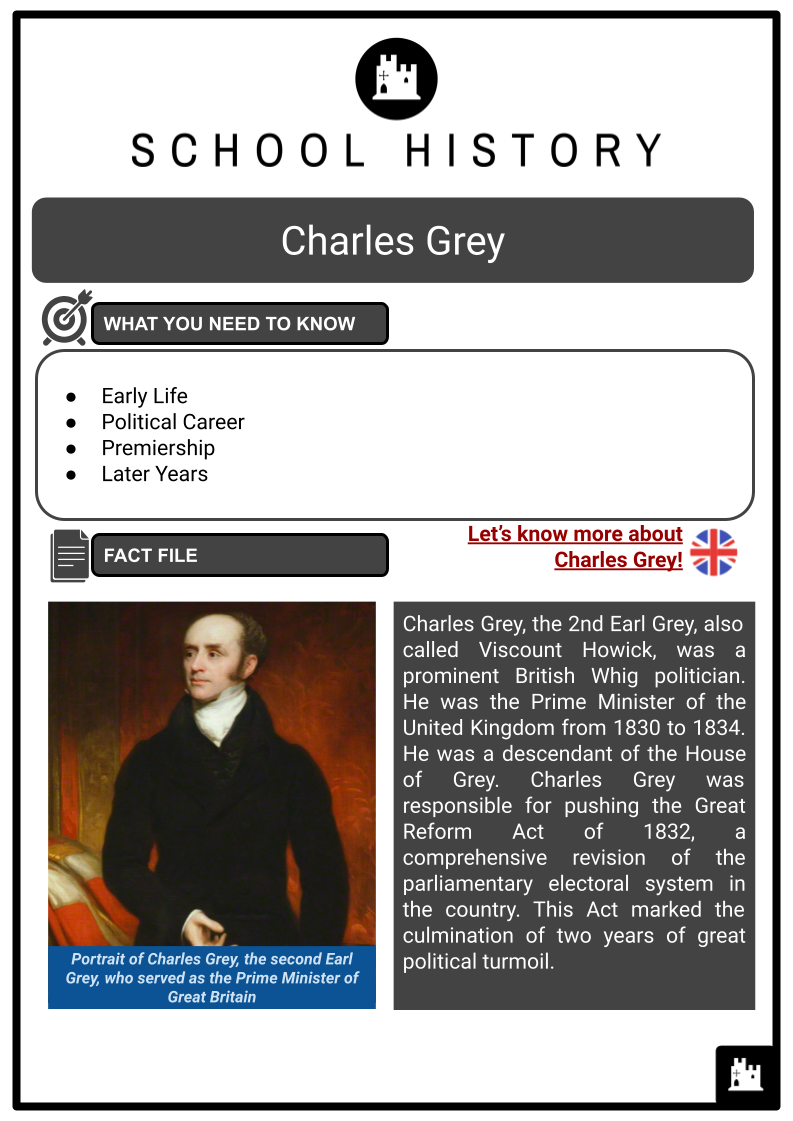
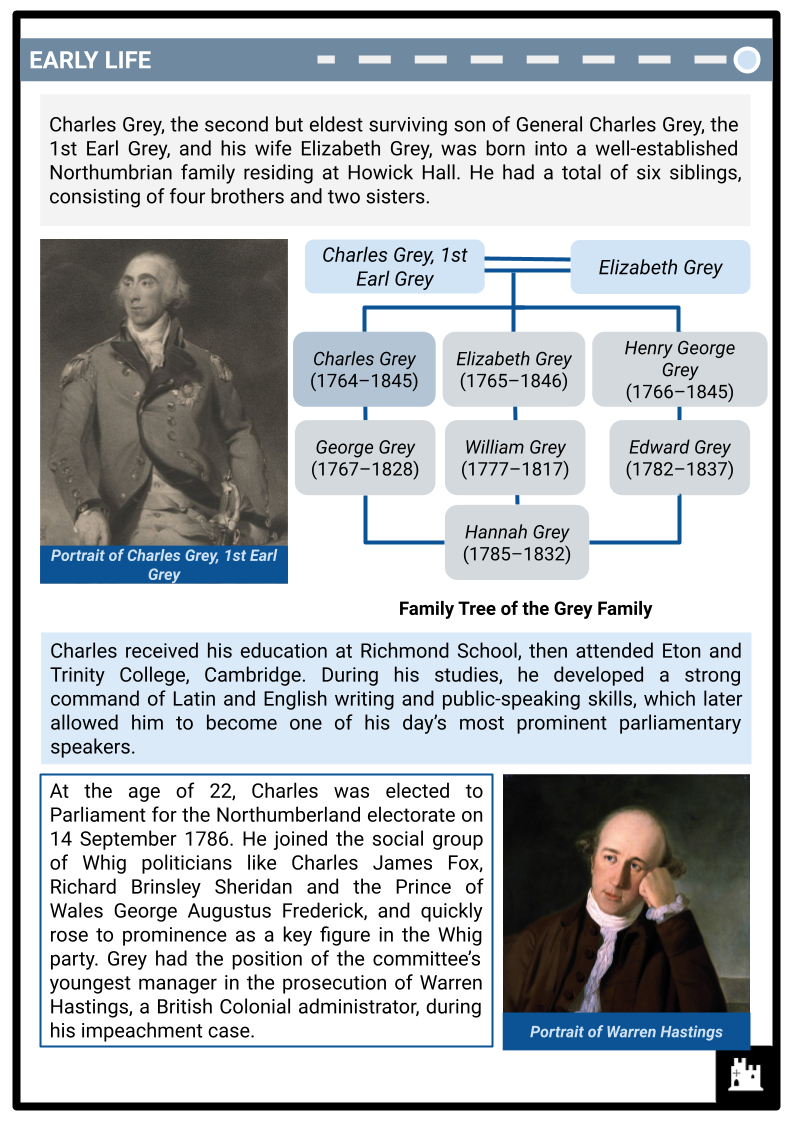
Student Activities
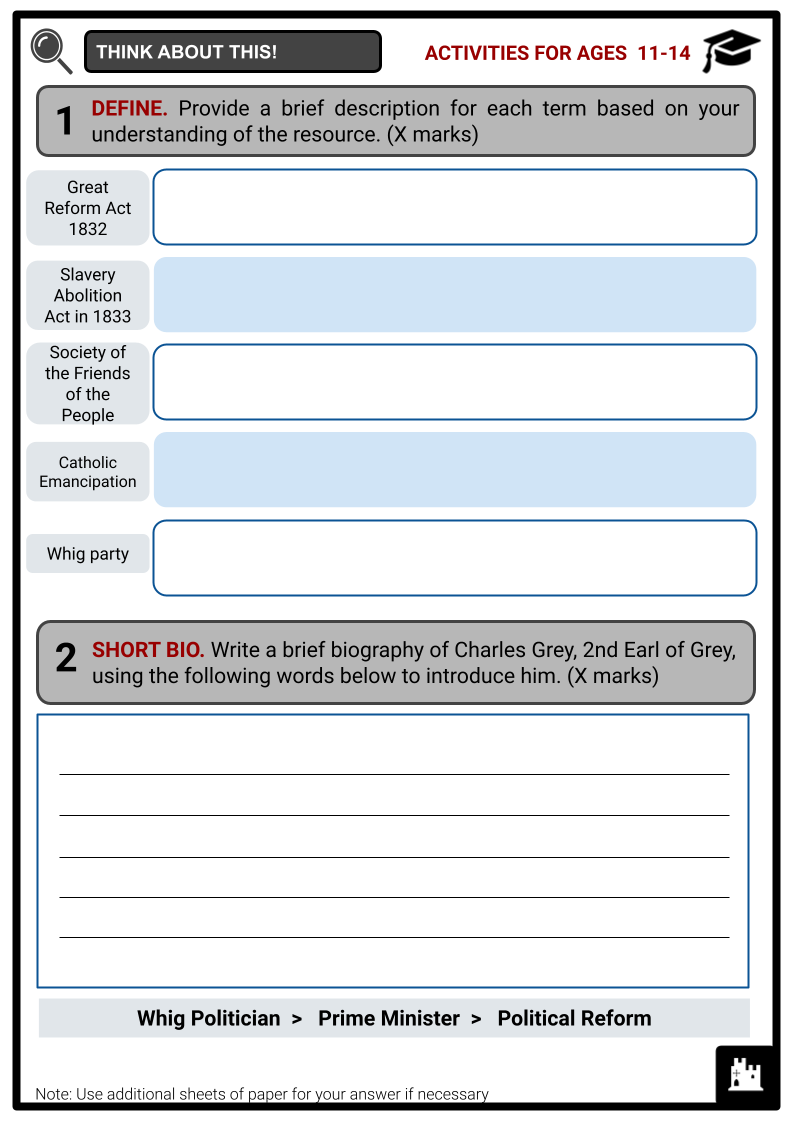
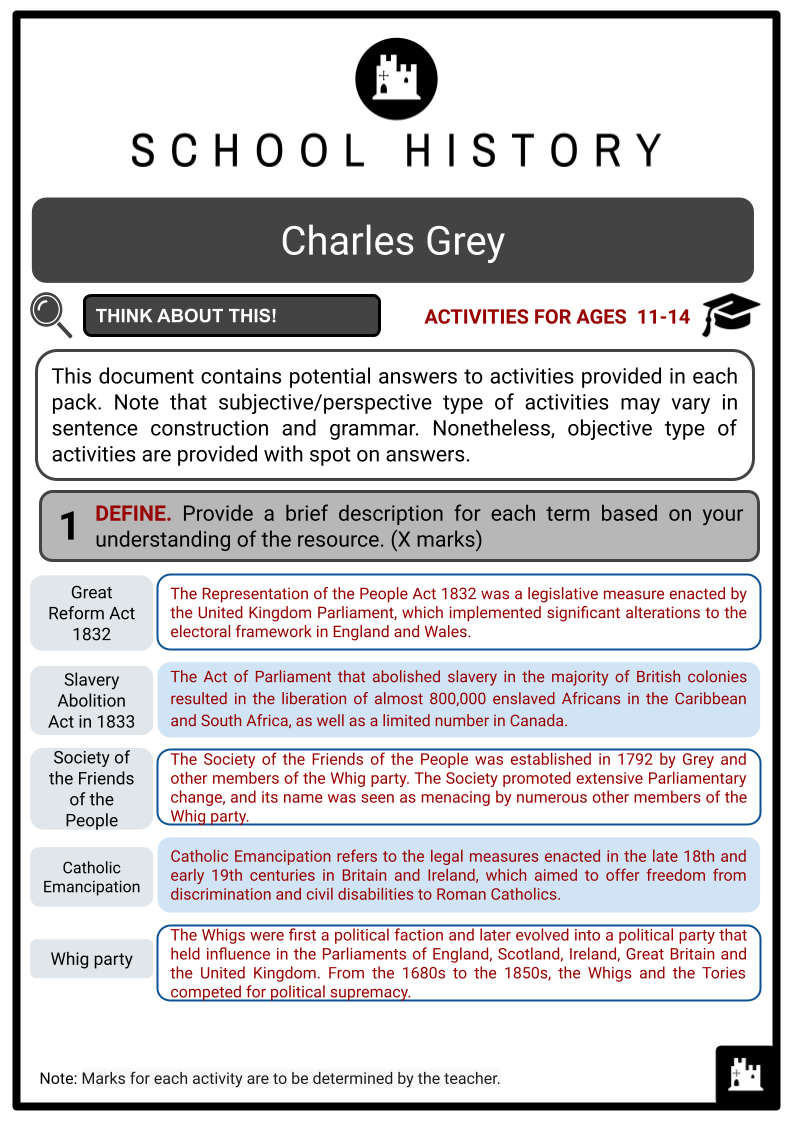
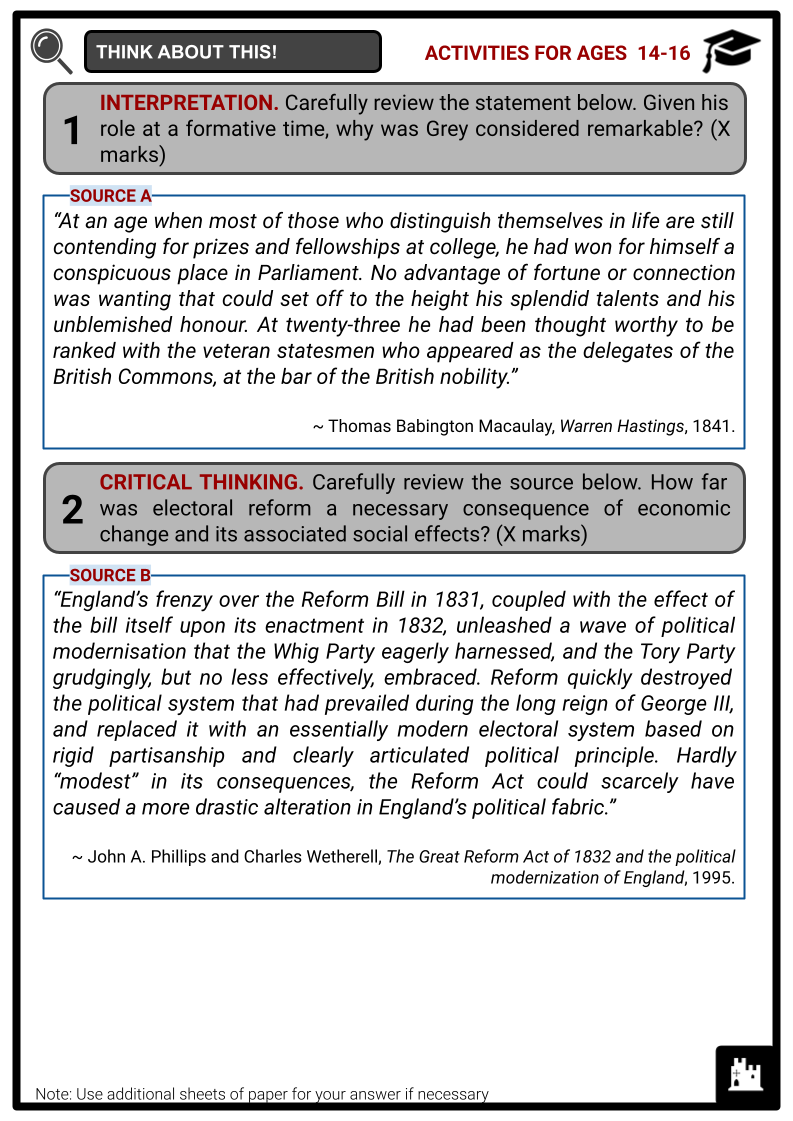
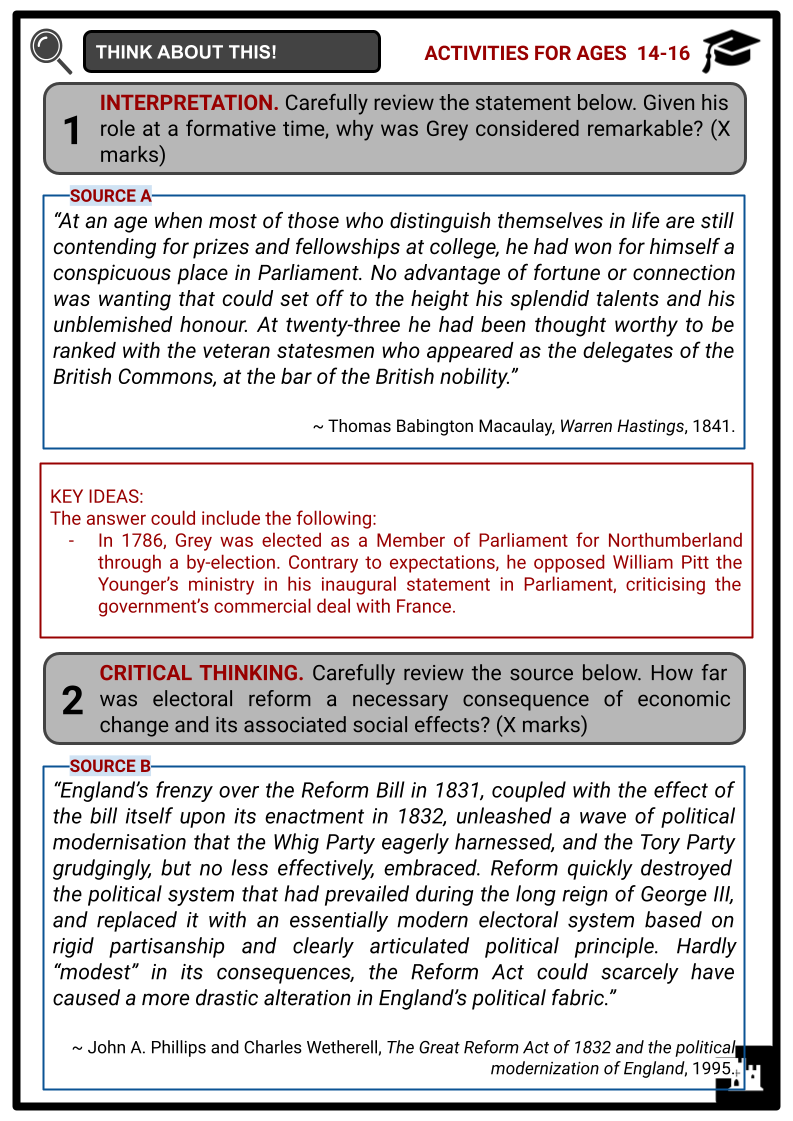
Summary
- Early Life
- Political Career
- Premiership
- Later Years
Key Facts And Information
Let’s know more about Charles Grey!
Charles Grey, the 2nd Earl Grey, also called Viscount Howick, was a prominent British Whig politician. He was the Prime Minister of the United Kingdom from 1830 to 1834. He was a descendant of the House of Grey. Charles Grey was responsible for pushing the Great Reform Act of 1832, a comprehensive revision of the parliamentary electoral system in the country. This Act marked the culmination of two years of great political turmoil.
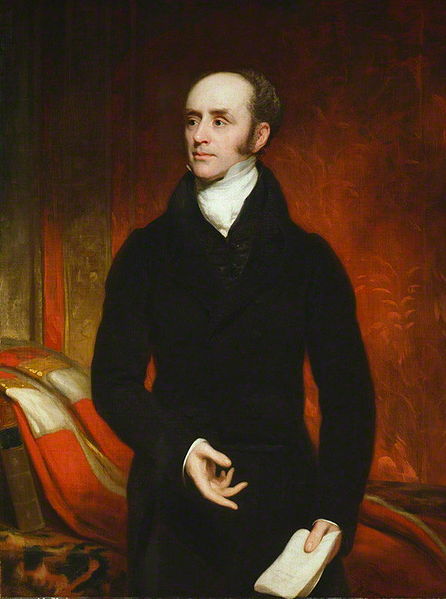
EARLY LIFE
- Charles Grey, the second but eldest surviving son of General Charles Grey, the 1st Earl Grey, and his wife Elizabeth Grey, was born into a well-established Northumbrian family residing at Howick Hall. He had a total of six siblings, consisting of four brothers and two sisters.
- Charles received his education at Richmond School, then attended Eton and Trinity College, Cambridge. During his studies, he developed a strong command of Latin and English writing and public-speaking skills, which later allowed him to become one of his day’s most prominent parliamentary speakers.
- At the age of 22, Charles was elected to Parliament for the Northumberland electorate on 14 September 1786. He joined the social group of Whig politicians like Charles James Fox, Richard Brinsley Sheridan and the Prince of Wales George Augustus Frederick, and quickly rose to prominence as a key figure in the Whig party. Grey had the position of the committee’s youngest manager in the prosecution of Warren Hastings, a British Colonial administrator, during his impeachment case.
- Grey was renowned for his advocacy of both Parliamentary reform and electoral reform. The principles of liberty, freedom and equality gained widespread acceptance across Europe and other regions during the French Revolution.
- In response to the growing desire for universal suffrage in Britain, the government enacted stringent laws in 1790 to suppress sedition and revolutionary actions that were seen as contrary to the democratic principles upheld by the nation.
- Implementing these restrictions was carried out by the prevailing Tory Party and Prime Minister William Pitt the Younger, whose subsequent term was derogatorily referred to by his adversaries as Pitt’s Terror.
- Charles Fox and Richard Sheridan Brinsley, prominent supporters and guides of Grey, criticised the government’s efforts to stifle reform movements because of their connection to revolutionary principles.
- In 1792, Charles was pivotal in submitting a petition to Parliament advocating for reforms that aimed to reinstate electoral freedom, achieve a fairer representation of the population in Parliament, and ensure that the people had more regular opportunities to exercise their right to elect their representatives.
- The 1792 petition yielded little alteration. However, in 1832 he pursued the objective more effectively with the enactment of the Great Reform Bill. He advocated for Catholic emancipation as part of his pursuit of more equitable representation.
- During this time, Charles had a romantic involvement with Georgiana Cavendish, Duchess of Devonshire, who was also actively engaged in political activism. Their relationship had no negative consequences on Charles’ part. However, it nearly resulted in her being legally separated from her husband.
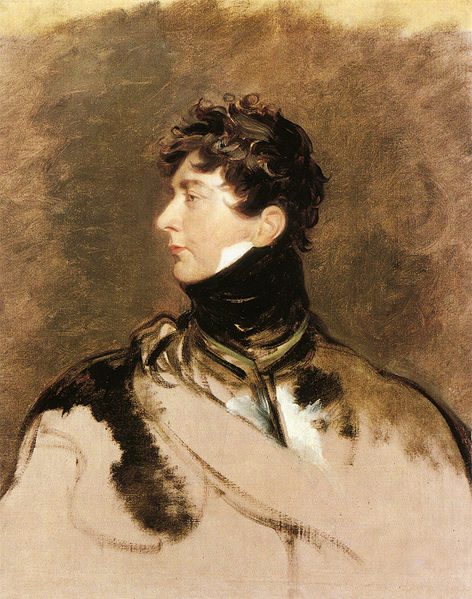
POLITICAL CAREER
- In 1806, Charles, who had assumed the title of Lord Howick due to his father’s promotion to the rank of Earl Grey, joined the Ministry of All the Talents. The Ministry of All the Talents was a coalition of Foxite Whigs, Grenvillites and Addingtonites, and Charles served as the First Lord of the Admiralty.
- After Fox’s demise later that year, Charles assumed the roles of foreign secretary and Whigs head. In 1807 the Ministry of All the Talents was disbanded due to King George III’s opposition to the Catholic Emancipation legislation. The King demanded all ministers, including Charles, sign a promise stating they would not advocate for additional concessions to the Catholics.
- In the subsequent year, the administration lost its authority. Following a short tenure as a member of Parliament for Appleby from May to July 1807, Charles transitioned to the House of Lords, inheriting his father’s title as Earl Grey. He remained in opposition for the subsequent 33 years.
- Grey was on the verge of joining the government at many points throughout this period. In 1811, Prince Regent George Augustus Frederick, who would later be crowned King George IV, attempted to persuade Grey and his ally William Grenville to join the Spencer Perceval cabinet after Richard Wellesley, 1st Marquess Wellesley, resigned.
- Grey and Grenville declined due to the Prince Regent’s refusal to make any compromises about Catholic Emancipation. The Prince Regent’s already tense relationship with Grey became much more strained when his distant daughter and inheritor, Princess Charlotte, sought Grey’s guidance on evading her father’s chosen spouse.
- Grey adhered to the conventional Whig party stance during the Napoleonic Wars. The Napoleonic Wars (1803–1815) were battles between the First French Empire led by Napoleon against other European alliances. Grey’s initial enthusiasm for the Spanish insurrection against Napoleon waned with the defeat and death of Sir John Moore, the British forces’ leader in the Peninsular War, as he grew convinced of the French emperor’s invincibility.
- Grey first hesitated to acknowledge the military achievements of Arthur Wellesley, 1st Duke of Wellington, Moore’s replacement. Upon Napoleon’s initial abdication in 1814, Grey opposed reinstating the House of Bourbons’ autocratic monarchy. However, when Napoleon was again reinstalled the following year, Grey regarded the transition as an internal affair of France.
- In 1826, due to his belief that the Whig party disregarded his beliefs, Grey resigned as leader and handed over the position to Henry Petty-Fitzmaurice, 3rd Marquess of Lansdowne.
- In the subsequent year, George Canning assumed the position of prime minister, replacing Robert Jenkinson, 2nd Earl of Liverpool. Consequently, rather than Grey, Lansdowne was invited to join the government to bolster its ranks after the departures of Robert Peel and Arthur Wellesley, 1st Duke of Wellington.
- Upon assuming the role of prime minister in 1828, Wellington specifically excluded Grey from being appointed to the government, as indicated by George IV.
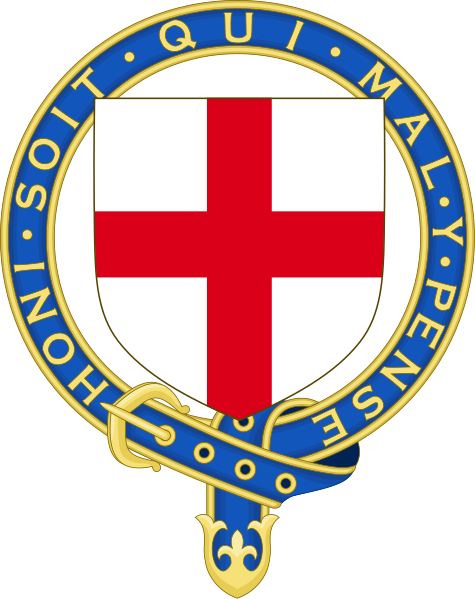
PREMIERSHIP
- In 1830, after George IV’s passing and Wellington’s resignation due to the issue of Parliamentary reform, the Whigs regained power, appointing Grey as the prime minister. In 1831, Grey was appointed as a member of the Most Notable Order of the Garter. The Order is a prestigious order of knighthood established by Edward III of England in 1348.
- During Grey’s tenure, significant achievements were made, including the Reform Act of 1832, which brought about much-needed changes to the House of Commons, and the Slavery Abolition Act of 1833, which effectively abolished slavery in practically all territories of the British Empire.
Reform Act 1832
- The French Revolution in 1789 caused a significant decline in support for legislative reform. Many English politicians developed a resolute opposition to any substantial political alteration.
- Notwithstanding this response, numerous factions of the Radical Movement were formed to advocate for reform.
- In 1792, an organisation promoting parliamentary reform was established by a faction of Whigs led by James Maitland, 8th Earl of Lauderdale, and Charles Grey. Their group was known as the Society of the Friends of the People and consisted of 28 Members of Parliament.
- The organisation released a document entitled Report on the Status of Representation. This contained the misconduct, graft, and overall insufficiency within the parliamentary electoral system.
- The report revealed that the lower house of the Parliament of the United Kingdom, known as the House of Commons, was chosen through the influence of small groups or individual patrons rather than by the general public, highlighting the urgent need for reform.
- Grey served as the Parliamentary spokesperson for the Society, and in 1793 and 1797, he advocated for change in the House of Commons. However, he was consistently defeated by significant majorities on both occasions.
Why did Grey support parliamentary reform?
There are two possible explanations that can be provided.
-
- Firstly, as proposed by Grey himself, the purpose of the reform was to prevent the potential violence of a popular uprising.
- Secondly, to redirect public enthusiasm towards a moderate plan. This plan aimed not to empower the people but to diminish the electoral influence of the Crown and the government, reinforcing the existing constitutional safeguards against royal tyranny.
- The primary objective was to diminish the monarchy’s authority by limiting its control of elections and electoral patrons. This reform aimed to enhance the representativeness of Parliament and reinstate the appropriate and traditional balance between the Crown and Parliament within the Constitution.
- Grey advocated reform to reinstate the previous Constitution rather than establish a novel, democratic one. Nevertheless, there exists an alternate, more pragmatic explanation.
- The reforms suggested by the Society of the Friends of the People would undoubtedly increase the participation of individuals in parliamentary elections. However, they would not liberate these individuals from the control exerted by their employers, landowners and other social superiors.
- Reforming the electoral system by diminishing the Crown’s control over parliamentary elections would amplify the upper classes’ sway over the voting population, augmenting their authority over the government.
Why then was Grey able to pilot the Great Reform Bill through Parliament in 1831–1832?
- His motives remained unchanged. However, the chance in 1830 was novel. Public support for reform resurfaced in the late 1820s due to several factors.
- Firstly, the affluent middle classes, experiencing increasing wealth and prosperity, now demanded a greater say in political matters.
- Secondly, the emergence of industrial and commercial towns like Manchester, Sheffield and Birmingham, which needed more representation in Parliament, highlighted the outdated nature of the existing representative system.
- Lastly, the more moderate revolution in Paris in 1830 ignited liberal enthusiasm for reform in England.
Grey and Slavery Reform
- The Slave Trade Act of 1807 prohibited the trading of enslaved people within the British Empire. However, it did not make slavery itself illegal. Slavery remained lawful until the enactment of the Slavery Abolition Act in 1833.
- After a prolonged period of advocating, Wilberforce witnessed Grenville presenting the Abolition Bill to the House of Lords, the higher chamber of the Parliament of the United Kingdom.
- Following its approval by the House of Lords, the Whigs experienced a highly anticipated advancement and subsequently proposed a second reading in the House of Commons on 23 February 1807. In 1833, the Whig administration, headed by Grey, presented a Bill aiming to eliminate slavery.
- Wilberforce passed away on 29 July 1833, and within a month later, the House of Lords enacted the Slavery Abolition Act, thereby terminating slavery in the majority of the British empire starting from August 1834.
Catholic Emancipation
- The subject of Ireland was the catalyst for the termination of Grey’s premiership in 1834. Henry Paget, the 1st Marquess of Anglesey, the Lord Lieutenant of Ireland, advocated for conciliatory reform. This included partially redistributing income from tithes to the Roman Catholic Church rather than the established Church of Ireland. This strategy is sometimes referred to as appropriation.
- Amid internal disagreement, the cabinet became divided. Lord John Russell highlighted these divisions regarding appropriation in the House of Commons, which led to the resignation of Stanley and other members.
- As a result of this event, Grey decided to withdraw from public life, allowing William Lamb, the 2nd Viscount Melbourne, to take over his position.
- In contrast to most politicians, he seemed to have truly favoured a private existence – his colleagues cynically said that he would threaten to retire after every failure.
LATER YEARS
- Grey enjoyed his final years in a state of contentment, albeit occasionally experiencing restlessness while residing in Howick with his collection of books and with his family.
- In his later years, he had a significant personal tragedy when his beloved grandson, Charles, passed away at the tender age of 13. Grey saw a decline in physical strength during his latter years and passed away peacefully in his bed on 17 July 1845. He was interred at the Church of St Michael and All Angels on the 26th, in the company of his family, intimate acquaintances, and the workers on his property.
Frequently Asked Questions
- Who was Charles Grey?
Charles Grey, 2nd Earl Grey, served as Prime Minister of the United Kingdom from 1830 to 1834. He is best known for his role in passing the Reform Act of 1832.
- What was the significance of the Reform Act of 1832?
The Reform Act of 1832 was a landmark piece of legislation in British politics. It expanded the electorate by increasing the number of eligible voters and redistributing parliamentary seats better to reflect population shifts due to the Industrial Revolution.
- What were some other key accomplishments of Charles Grey's government?
In addition to the Reform Act of 1832, Grey's government abolished slavery in most of the British Empire with the Slavery Abolition Act of 1833. They also implemented various social and economic reforms to improve conditions for the working class.
